The Cart
The Cart
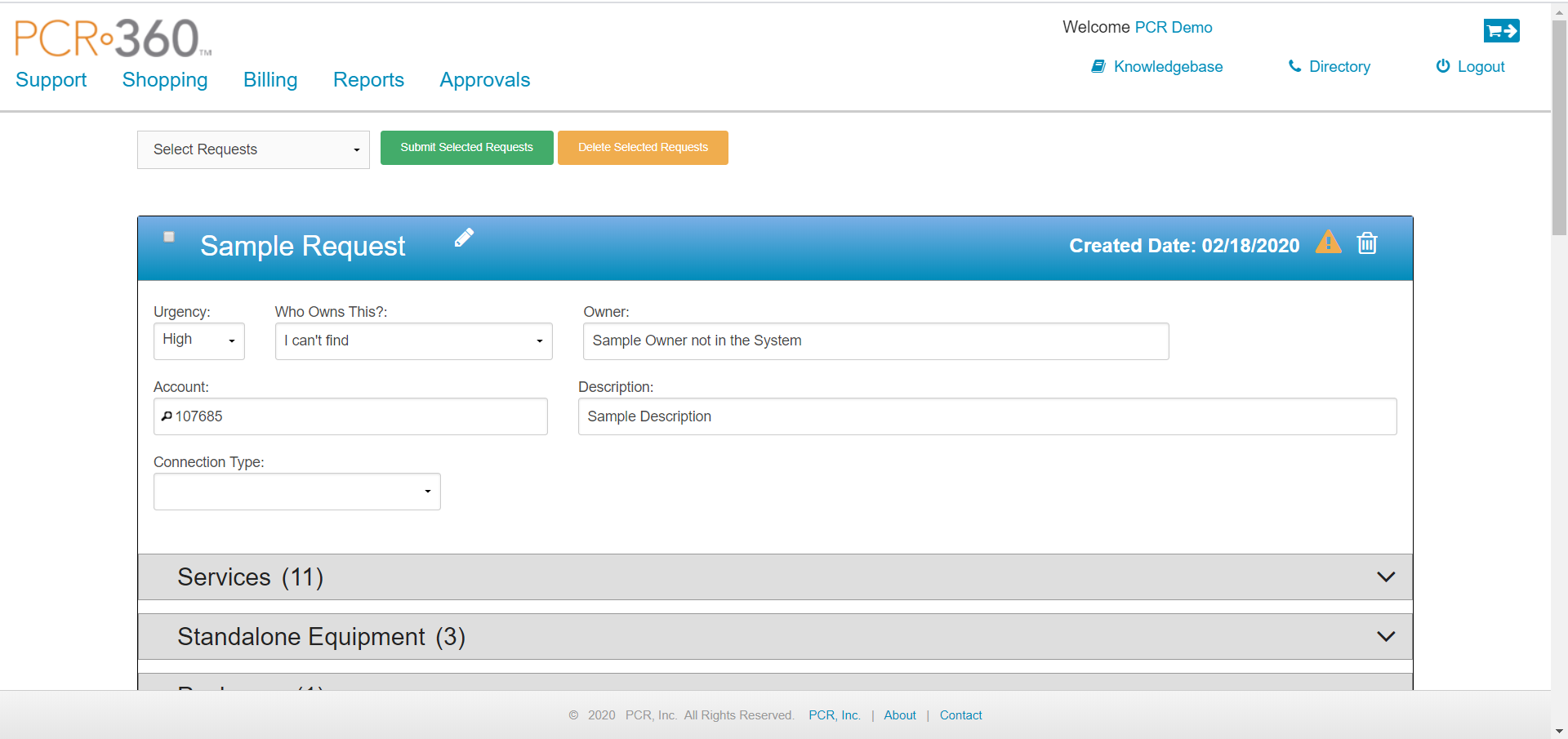
Example of Cart
To open the Cart, just click on the
From the Cart, a User can manage Pending Requests and submit/delete one or more Requests. The User is also given the option to Select All Pending Requests, Deselect All Pending Requests (Select None) or Select All Pending Requests of one type.
To Select a Pending Request, the User must 


To Delete just a singular Request, the User just needs to click the 
In Order to find Pending Requests more quickly, a User can utilize the search bar. The Pending Request search bar works slightly differently than other search bars within PCR-360 in that it will only match based on the Request's Title.

Pending Request Search Bar example
The Cart will only load four (4) Pending Requests initially. If more exist a User can load more with the below button, which is located underneath the last loaded Request.

Load More Requests button example
When no more Requests are present to be loaded, the button will display a message for no more Requests in its place.

No More Requests message example
Types of Pending Requests

Types of Pending Requests
Ready to Submit - These Requests are completed and are ready to be submitted
Incomplete - These Requests are missing Required pieces of information and require further action by the User. These Requests are usually marked with the
 icon.
icon.
Request Management
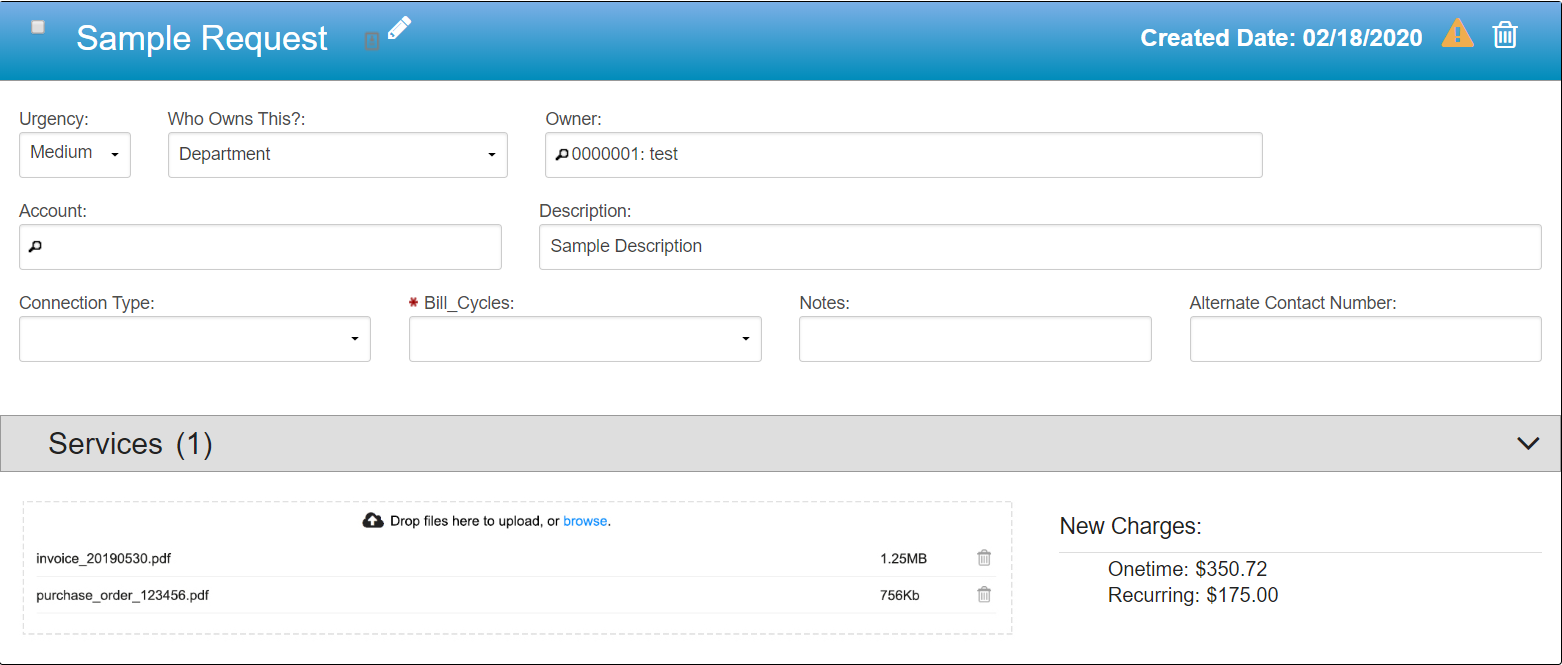
Same Request
To add New Services, Equipment, and Packages, see their respective articles for information about adding them to the Cart. New or Changes to existing Services, Equipment, and Packages are displayed fully expanded on the Request in the Cart but can be collapsed to simplify the view on the screen.
Each Request is Editable from the Cart. The User can update the Urgency, Owner, the Charge Account, the Description, manage Attachments, and any other User-Defined Fields on the Request. The User can also update Changes to the Service and related Equipment/Packages.
Each Request can also be Titled uniquely to help group the details for each Request.
A summary of the Charges will be displayed at the bottom right corner of the Request.
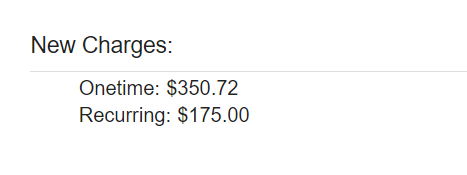
Summary of Charges Example
Title
A Request can be uniquely named and updated to help a User differentiate multiple Requests being worked on (such as setting up Orders for multiple different Users). To edit the title, click the 
Urgency
Urgency allows the User to indicate how important a Request is. Examples of Urgency are Low, Medium, and High. Depending on Organizational needs, the system may be configured to behave differently depending on the Urgency.
Owner Information
The Owner Information fields are comprised of two separate fields. The Who Owns This one and the actual Owner one. Together they enable the application to determine who the Own of the Service should be.
Who Owns This
This dropdown consists of three options. Contact, Department and I Can't Find.
Contact - Selecting this option means the Owner is an individual person.
Department - Selecting this option means the Owner is a Department.
I Can't Find - Selecting this option means the Owner is not setup in the application yet, such as a new hire, or a pending new Department.
Owner
The Owner picker is filtered depending on the Who Owns This field. When set to Contact, the picker will only display Contact records, while when set to Department, the picker will only display Department records.
When Who Owns This is set to I Can't Find the picker becomes a free text field for the User to enter the Owner manually.
If the logged-in User is not a Coordinator the Owner field will be auto populated to that Users details.
If the logged-in User is a Coordinator the Owner field will be restricted to Departments that they coordinate if the Who Owns This dropdown is set to Department. If set to Contact, it is restricted to Contacts within the Departments that they coordinate.
Charge Account
The Charge Account is always a Required field if the Service Catalog for the selected Service is "Billable". The GLA picker restrictions are determined by a number of factors. If the logged-in User is not a coordinator, the GLA permissions will be the User's GLA permissions. If the User is a coordinator the Owner field will be restricted and the intersection between the Owner and User's GLA Permissions will be used. If there are no User GLA Permissions, the inherited GLA permissions of the Departments that they Coordinate will be used.
CustomerCenter User GLA permissions chart example
For more information on how the Department Hierarchy or a Contact's association affects GLA permissions, please see the Department Hierarchy and People page.
Description
The Description field is used to describe the need for the Service or any other details related to the Request, but will not necessarily appear on the final product of the Request itself.
Attachments
Any file less than 10Mb in file size can be attached to the Request for review.
Items on the Request
Each individual Service, Standalone Equipment or Package is hidden by default on the Request. A User can view them by clicking the 

When expanded (




When editing one item in the category, the User can click the 


The Cabling Picker will appear on all Service Add Actions, as well as, on Packages. The Cabling Picker is restricted by location on Service and Package Actions. The picker is also restricted by the Service's catalog location restrictions on service actions. The Cabling Picker is not a Required field and will only appear if CC_SHOW_CABLING_PICKER is true.
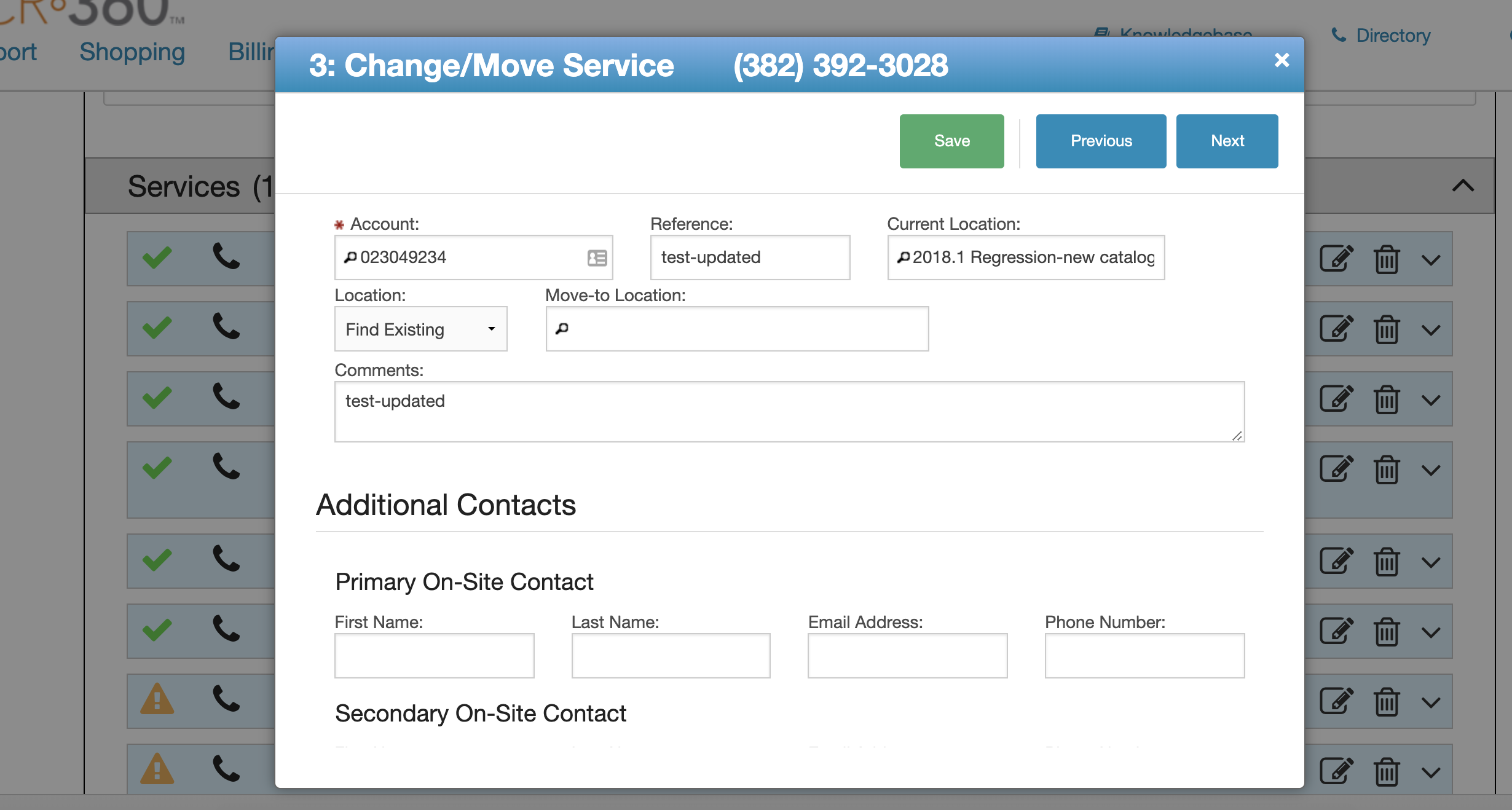
Sample Service Change Item
Services

Related Service Changes Bar Example
There are a number of available items available for a Service Request or Equipment Installation.
For new Services being Requested, the most common Service Changes are Add/Install. Other items are more common when a User desires an update to an existing Service.
For Services and Equipment that require a Location, a User has two options:
Find Existing - This allows the User to select an existing record from the system.
I Can't Find - Selecting this option means the Location is not setup in the application yet, such as a new building.
For Services being Changed or Moved, the Reference Field is available. This is a free text field for the User to enter information specific to the Action.
Standalone Equipment

Related Standalone Equipment Bar Example
Standalone Equipment is any piece of Equipment that is not associated with any specific Service. Equipment that is associated with the Service will appear in the Service Changes section.
Related Packages

Related Packages Bar Example
Packages are bundles of related Services and Equipment that your Organization has defined as being needed together. Packages expedite a User's ability to request multiple commonly needed items at once.
User-Defined Fields
Any UDF that shows in the CustomerCenter is Required to follow the rules set on the UDF by the Administrator. If there are User Defined Fields (UDFs) associated with the Service Catalog, Service Desk Actions, or (2024.1) Service Orders that have the "Show in Cust Center" flag set to true, they are displayed on the Request.
Action UDFs, Service UDFs, Service Order UDFs, and Incident UDFs are the four types of UDFs that appear in CustomerCenter, but Incident UDFs will not show up in the Cart. At this time, Equipment UDFs will only show up on “Incident Request”, not Service Requests or Service Actions. Service UDF's show up in a section above "Additional Information" with a heading of "Information for <service ID>" i.e. "Information for Fantastic Company”.
For more information on UDFs in the CustomerCenter please see the CustomerCenter section on the User-Defined Fields page.
Association Criteria vs. Second Association Criteria
The Service Catalog is the criteria and it can be empty. The Service Desk Action Type is the Second Association criteria and it cannot be empty. The Second Association criteria will default to the "Add" action type.
Split Funding
Using the configuration CC_SPLIT_FUNDING your organization can enable splitting funding for items in the Cart across multiple GLA Accounts.

Split Funding Example
To add more GLA Accounts to the Cart item, select the desired Account in the picker and then click the 
Draft Requests
After all of the Order Details are submitted, Users have the option to wait until later or to submit the Request right now. When a User decides to wait until later, the Request can be viewed and resumed in the Cart.
These drafts will remain in the Cart until they are either submitted or until they expire.
Expired Requests
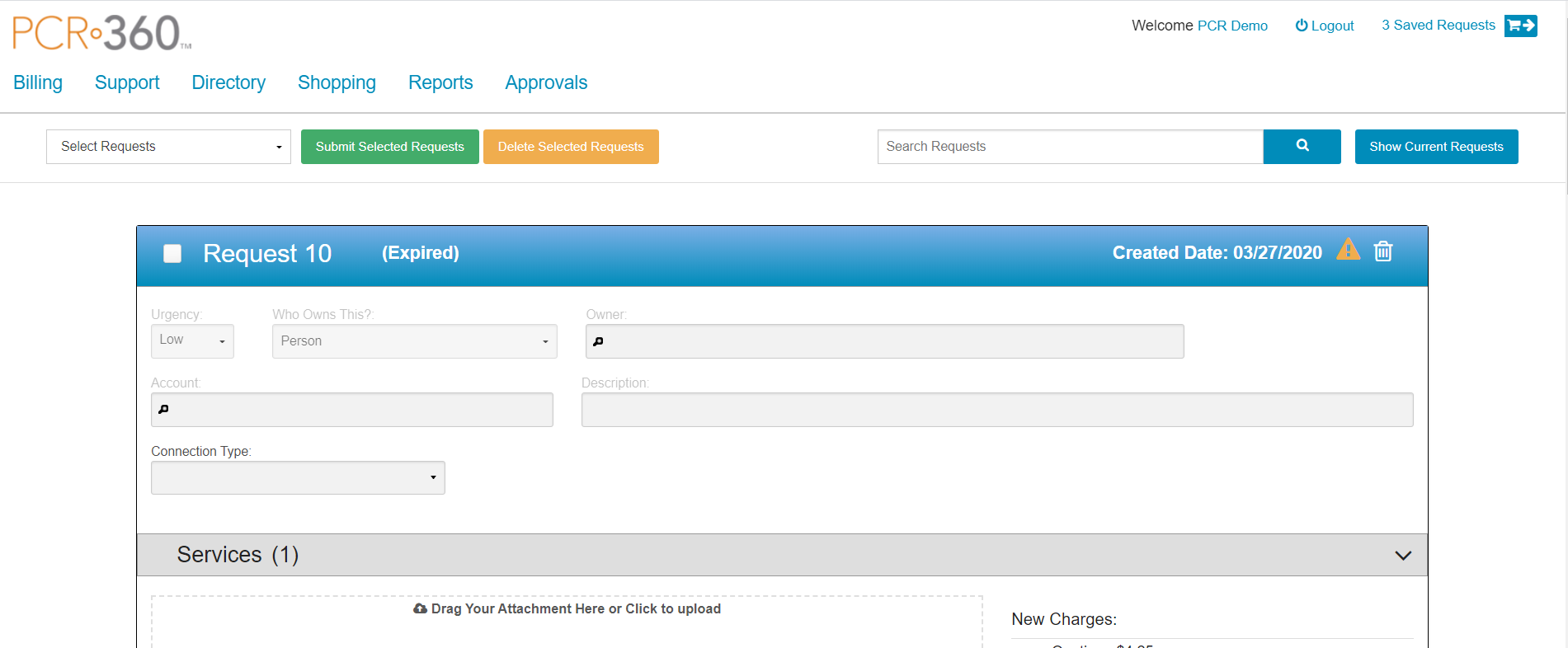
Example of Cart
After a period of time, Pending Requests will Expire. Expired Requests along allow you to view the General Details (not individual item changes on Services/Standalone Equipment/Packages), and Delete the Request. The period of time a Request has is configured by CC_REQUEST_EXPIRATION_DAYS, which has a default value of 30 days.
To view Expired Requests click the


Submitted Request Summary
Order Summary
When a Request is submitted successfully the User receives a summary of Request that was submitted.
Service Rep Information:
Pending Approval
Some Requests require approval. If Approval is Required, once on the Cart page, the Request will have a message on it stating: "This Request will require approval after it is submitted".

After the Request is submitted, it is set to Pending Approval. Request Tracking is available for Users to view the current status of their submitted Requests. Users can see their Pending Requests on the Cart page by selecting the drop down menu, and choosing the "Pending Approval" option. The Approval process gives a Coordinator a chance to review any Request that originates from the CustomerCenter before the Request is submitted to the Requests grid. Please visit the Approvals page for more information on the Approval process.
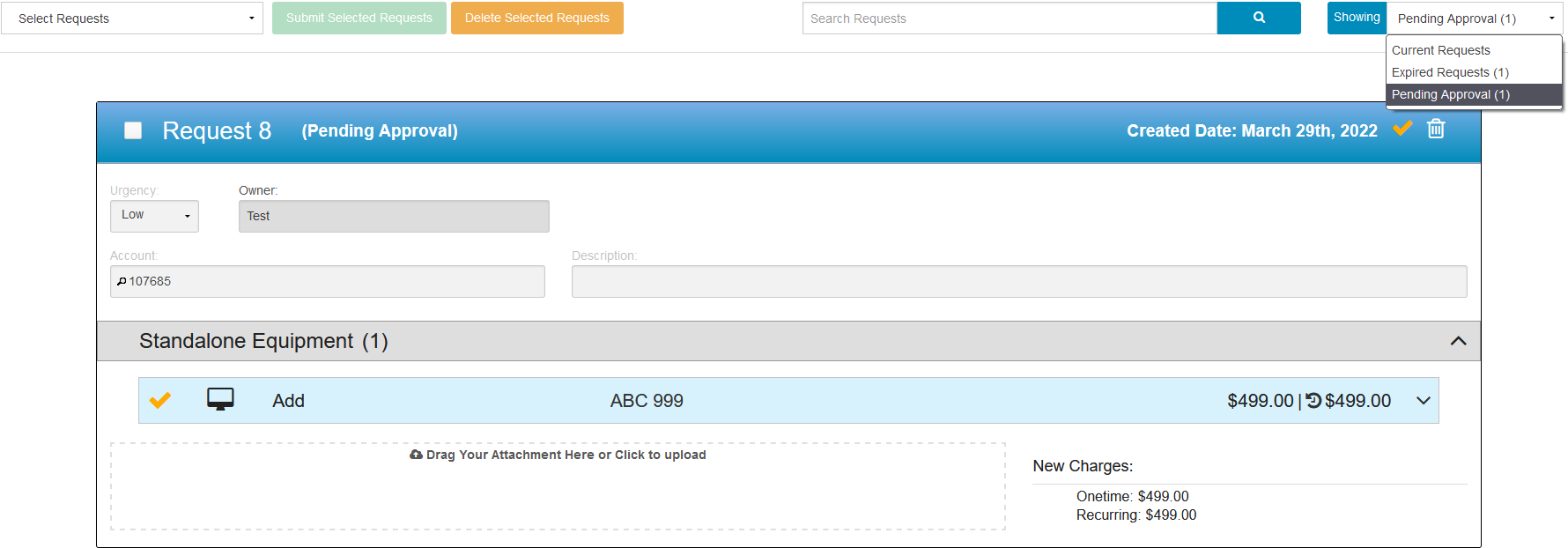
Pending Approvals in Cart example
